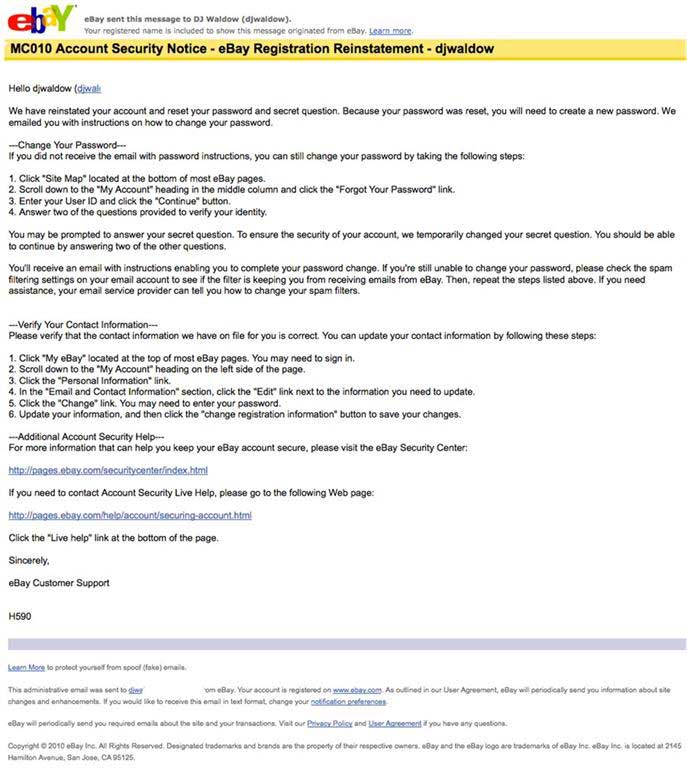I'll never forget my first purchase on eBay. In 1999, I bought a 7-wood golf club in hopes that it would improve my game. No such luck. It turns out that when you are a mediocre golfer, the club doesn't matter that much.
But anyway...
Did I mention the year was 1999? Think back a bit. Wikipedia was just getting started. Blogs were in their infancy. Email and email marketing were not nearly as ubiquitous as they are today. LinkedIn, Twitter, Facebook, Digg, MySpace, etc.—not even thought up yet.
Fast-forward 11 years to 2010: I attempt to login to my eBay account for the first time in nearly eight months and receive a message that my account has been blocked; I call the eBay support number so kindly supplied, and speak with an extremely helpful gentleman who tells me that my account was locked due to "suspicious activity"; he goes on to explain phishing scams to me.
(More on phishing: the best video definition, in under three minutes, from Common Craft.)
Fair enough. I actually appreciated that eBay was looking out for me. eBay reset my account and sent me an email. Life was back to good again... until I actually saw the email:
What eBay Did Wrong
People tend to open an email based on the two things they can see in their inbox: the From name and the Subject line. (Note: There are also people who open every single email.)
If I receive an email from a sender I do not recognize or trust, I'm less likely to open it. If an email with a "suspicious" Subject line lands in my inbox, it's most likely to be deleted or marked as spam.
The email eBay sent me included the following:
- From name: "moreinfo"
- Subject line: "MC010 Account Security Notice - eBay Registration Reinstatement—djwaldow"
Yikes. I'm not sure who "moreinfo" is. And, wow, does that Subject line look spammy! Wouldn't it have been better if the From name were simply "eBay" and the Subject line something like "Your eBay Account Has Been Reactivated"?
Am I right? Are you with me? Why make me guess who the email is from? Why write a Subject line that has words like "MC010" and "Security" in it? (And does anyone know what "MC010" means)?
What eBay Did Right
If you watch the Common Craft video linked to above, you'll see that the copy of the eBay email includes many of the components that Common Craft do not look like a phishing email. However, if I never open the email—due to the spammy From name and Subject line—how would I ever know?
Let's set aside for a moment the spammy From name and Subject line. Here's what I do like about eBay's email:
Preheader: In the preheader—image and copy—eBay reassures me that the message was sent from eBay to me (see below). My full name and eBay username are both included. Even better, there's a link to learn more: Clicking on "Learn more" redirects me to a page that does an excellent job of explaining how I can tell whether an email is really from eBay.

Personalization: Though not typically a fan of first-name salutation personalization, I think in this case it worked for me. Why? It referred to my eBay username and email address—both of which I recognize immediately.
Copy: While it is a bit text-heavy for my taste, the copy is clear and easy to understand.
Links: eBay gives me a few links for additional security-related help. Very nice.
Footer: The bottom of the email once again provides a link to "Learn more" about spoof (fake) emails. This time, however, clicking on the link takes me to a fun, cartoon-like tutorial. I'm not sure why this link is different from the one at the top, but... that's OK.
Note, however, that I would have been less likely to see all of the good, valuable information in this email because the poor From name and spammy Subject line might have kept me from opening the email.
What's Wrong (and How to Fix It)
Often, when I see emails like the one from eBay, their shortcomings are due to a disconnect between IT and Marketing.
In this case, eBay has done a nice job on its site of explaining what phishing is and how to avoid being duped. It has also trained its staff to clearly explain it on the phone. Moreover, the email has compelling, valuable copy. But, I'd bet that the IT department is the one that set up the triggered email.
Now, I'm not trying to point fingers or make judgments about IT departments—not at all. My point is that these emails, although transactional in nature, should be managed by the folks at eBay who send out the marketing emails.
If I were eBay, I'd want to ensure that I have consistent branding and messaging. I want consumers to trust eBay. I want them to read and engage with emails I send, not delete them out of fear of spam.
Lessons for Marketers
Although the example in this article is from eBay, think about your own company's email communications:
- Who sends email to your clients/customers/prospects?
- Do you know what those messages look like?
- Is the branding and messaging consistent?
- Is the From name recognizable and trustworthy?
- Does the Subject line make someone want to open it rather than delete it or mark it as spam?
If you are the person responsible for marketing in your organization, I encourage you to take these questions back to your team. Do a little digging. Ask around. You may be surprised at what you find.





